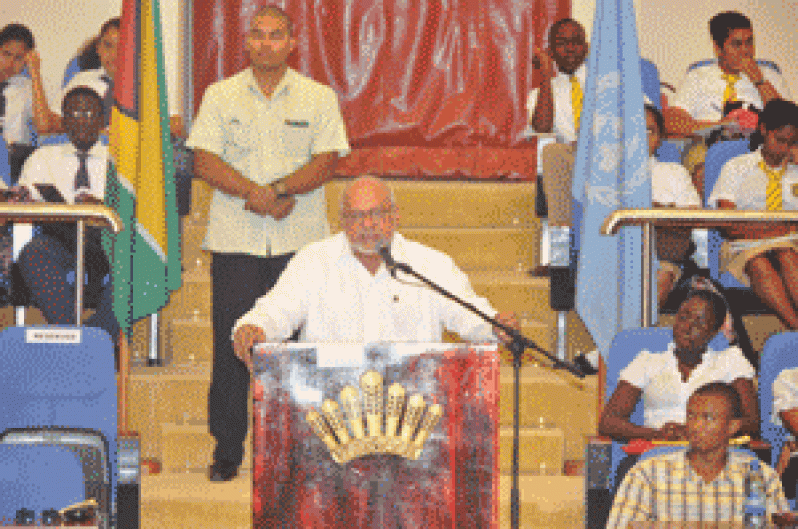 The release of the document, which coincides with UN Month activities, marks the first time such a publication is being launched in a Caribbean Community (CARICOM) member state.
The release of the document, which coincides with UN Month activities, marks the first time such a publication is being launched in a Caribbean Community (CARICOM) member state.It follows a previous publication that was launched last August in El Salvador, and an agreement between the Executive Secretary of ECLAC Alicia Barcena, and Guyana’s Minister of Foreign Affairs Carolyn Rodrigues-Birkett, who chairs the Caribbean Development and Cooperation Committee (CDCC), for a publication to be launched in the Caribbean.
The 75-page report proposes recommendations for countries in the Caribbean and Latin America to meet the goals of achieving high and sustained rates of growth to close structural gaps and generate quality jobs, change consumption and production patterns, and guarantee equality on the basis of greater convergence in the production structure with universal social protection and capacity building.
According to the report, such an endeavour requires the “return of politics and of the state’s role in promoting investment and growth, redistribution and regulation, with a view to structural change for equality, through industrial, macro-economic, social and labour politics.”
The compilation was influenced mainly by the challenges in recent years affecting the world, according to Director of the ECLAC sub-regional headquarters for the Caribbean, Diane Quarless, who was among those witnessing the launch.
 “The global crisis has pointed clearly to the need for an integrated approach to restructuring the regional economy so that it can deliver high growth rates, better living standards, and improved equality among different segments of the population,” Quarless said.
“The global crisis has pointed clearly to the need for an integrated approach to restructuring the regional economy so that it can deliver high growth rates, better living standards, and improved equality among different segments of the population,” Quarless said.Growth and development in Latin American nations like Brazil, which is today the world’s fifth largest economy, and how they managed to do it, even in a period of economic recession, were highlighted as models.
Guyana’s five consecutive years of growth and stability during the volatile period, and progress over the last two decades were also recognized. According to President Ramotar, these achievements came as a result of deliberate structural changes in the economy.
“Much of what we have achieved, over the last two decades, had to do with making important structural changes. First of all, philosophically, we always argued that it is impossible for us to have sustained economic and social development unless we have a strong democracy… that is one of the things that has been central to our activities,” President Ramotar said.
The move by the People’s Progressive Party Civic (PPP/C) Government, after taking office in 1992, to divert the bulk of the country’s revenue from administrative affairs to the social sector, was highlighted by President Ramotar as a model for structural change.
“It goes into strengthening human capital. We spend some 30 percent of our budget on the social sector: education, housing, water, pensions for the vulnerable,” President Ramotar said. With gender parity and universal access to primary education accomplished, attempts at narrowing the gap at the secondary level and the five rights commissions established under the Constitution of Guyana to promote the fundamental rights and rule of law, to name a few, Guyana has also identified with ECLAC’s integrated approach for equality of rights.
With gender parity and universal access to primary education accomplished, attempts at narrowing the gap at the secondary level and the five rights commissions established under the Constitution of Guyana to promote the fundamental rights and rule of law, to name a few, Guyana has also identified with ECLAC’s integrated approach for equality of rights.
Aspects of the publication highlight the need for governments to consider “re-igniting the engine of the private sector, including through investments in public private partnerships.”
Such a task, President Ramotar said, has already been accomplished through what he described as the Public Private Partnership (PPP) model that saw the commissioning of the Ogle International Airport and the Berbice River Bridge, and will lead to the Amaila Falls Hydropower Project, the Linden to Lethem road, and the deep water harbour.
“It’s a win/win situation for all the persons who are involved. For the government/state, it helps to get the important infrastructure in place for social and economic development, while it eases on some of the financial pressure… for investors, they are good solid investments, and of course the people in the end who benefit the most from these,” President Ramotar said.
Diversification of new high productivity sectors that use domestic capital and are environmentally friendly were cited in the publication as an important component for structural change.
The pursuit of natural competitive advantages for service products and the need to strengthen Information Communication Technologies (ICTs) and intellectual property were among the major recommendations. (GINA)



.jpg)









